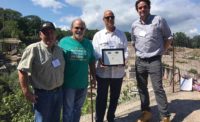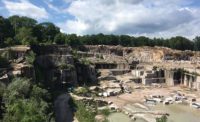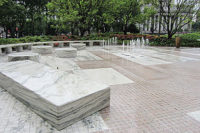Considered to be the most monumental addition to Liberty Island since the Statue herself, the new Statue of Liberty Museum opened to the public on May 16, 2019. The museum was built with three components – accessibility, education and sustainability – in mind, and permits 4.3 million annual visitors access without restrictive security clearances. And at the heart of the facility’s design is Stony Creek granite, which fits with the sustainable design objective, as well as historically connecting to the Statue of Liberty, as it was used for it pedestal more than 100 years ago.
The museum’s design was the work of FXCollaborative, located in New York, NY, who was invited to take part in a design competition and interview process by the National Park Service and the Statue of Liberty Foundation. “We went through a series of interviews and looked into potential sites all over the island,” said Brandon Massey, associate for FXCollaborative. “The most appropriate spot was in this area just to the north of Pine Plaza, which was a small wooded area between some existing underutilized buildings. That area would lend itself to a small museum. It would be nice and quiet and reflect the monument, but had enough space to be celebrated. As far as bidding for the job, it was a fairly competitive process where we presented several schemes and ideas, and went back and forth with the different groups.”
For the design, FXCollaborative wanted to create something that related and reflected the star-shaped fort, which is at the base of the Statue. The design team also had to do more than just raise the ground up a bit. On top of that, they also wanted to go with the original stone used as the foundation of the Statue of Liberty.
“Stony Creek granite was selected for the project because [the material] was used on the original pedestal,” explained Massey. “We felt that our material pallet needed to be contextual with the long history of the site. Stony Creek was the right selection because of its warm hue and history. Stony Creek is also a regional stone. We felt that was another important thing to do; to keep our materials as local as possible.” Complementing the Stony Creek granite in the plaza area is red brick, which has conceptual connections to several parks in New York City, according to the architect.
The biggest issue with designing the project was the physical size. “It is a small site and it is prone to flooding so we had to raise it 10 feet,” said Massey. “The staircase, the very surface you have to walk on, had to be raised up. It couldn’t be compromised. And we had to get everything in budget. Stone may not be the cheapest, but it is well worth it. It provides the right durability and lasts many generations. It also provides the right contextual message we wanted to send.”
Everything on the job had to be barged over to the island and all members of the team were on a tight schedule. Massey explained that the contractors did an exceptional job of scheduling everything. “Luckily the stone came in palleted and prefabbed so we could store it onsite and do prep work and get everything ready,” he said. “That was all being done while we did the waterproofing before installing the stone.”
The Flag Plaza was bisected for the purposes of staging. The north side was used to store and prepare the material before installation. “That area was very limited and not too large,” said Massey. “At one point it was filled with stone and the stone contractor had to assemble things in a neat and orderly fashion and they did. The dock was on the Ellis side of Liberty Island. That dock cut across our walkway, so we had to wait for construction to finish everywhere else and take apart the dock as we finished up the last sections of the Flag Plaza.”
Mock up methods used were many hand samples provided by Stony Creek, according to the architect. “They helped us understand what was possible finish wise; thermal is what we went with,” said Massey. “We fine-tuned it because we wanted a consistent finish that had grip, but soft enough to sit on and touch when sitting on benches. We also looked at the size of our pavers — 48 x 16 inches — and looked into a number of ways of jointing and laying those out, as well as the open joints and the grouted lower portion.”
A sustainable material
Darrell Petit of Stony Creek Quarry explained that FXCollaborative proactively contacted them directly about supplying material and that from the onset it was completely understood that their design team wanted Stony Creek Granite for the new museum. “The spec that they wrote was very clear to the extent that they went so far as to specify the geological makeup and exact coordinates of Stony Creek Granite,” he said. “That’s a clear directive from the architect and a definitive step forward in the process. Successful collaboration in writing a clear spec happens best when the architect reaches out first to the origin of the material.
“They had questions about specific details and budget,” Petit continued. “They also had questions about the Stony Creek Granite surfaces that they were thinking of using in such a high traffic and harsh outdoor environment.” Details including the tactile quality of surface treatments, edge conditions, freeze thaw conditions were all discussed. “They wanted a thermal finish,” said Petit. “But we all know that there are many different qualities of thermal finish. When done incorrectly thermal can be flakey and the color matrix muted, but when thermal finish is done correctly, the mica in Stony Creek becomes highly reflective in the natural sunlight and is brilliant. We wanted to help them understand that so that they would have options and could employ that level of custom detail in their design process.”
In total, approximately 5,000 cubic feet of Stony Creek granite was quarried for construction of the Statue of Liberty Museum. “It’s not a particularly large quantity for us. But the order was for all first quality blocks supplied to create custom cut to size architectural elements all to be installed to the highest degree and to be sublime in support of the profound visitors experience of the Statue of Liberty museum. We completed the quarrying in a four-month period during the winter of 2017-18”
According to Petit, besides the granite having historic ties to the project, the fact that the Stony Creek granite quarry is NSC 373 Gold certified was also an added benefit. “The sustainable aspect was appealing to the architect, the government, the Statue of Liberty-Ellis Island Foundation and the many corporate and private donors” he said.
Once the material was quarried it was shipped to North Carolina Granite Corporation (NCGC) to be fabricated. “We had the opportunity to bring our partner, North Carolina Granite, into the project,” said Petit. “They were a conscientious collaborator for this project. They have proven experience with historic projects in the country for over a century. They were thorough in their comprehension of the full extent and significance of this project and they performed admirably.”
Fabricating the stonework
Communication for the scope of a project such as this was a key component of the process. At the beginning of its involvement, NCGC discussed the block size, quarry production and transportation with Stony Creek Granite. “Stony Creek had to produce the blocks to a certain size to match the finished pieces to reduce the waste factor,” explained Doug Norman of NCGC. “Production and shipping was planned around the weather in Connecticut. We had to get as many of the blocks to NCGC as possible to meet schedules just in case there was a really bad winter. With everyone working together and knowing the importance all of the blocks were produced and sent to NCGC on schedule with no problems.”
On average, the typical paver size measured 4 feet x 1 foot, 4 inches. “There was so many areas of work that required certain sizes which ranged from 6 feet, 6 inches down to 1 foot, 2 inches — several thickness from 1¼ inches over 8 inches,” said Norman.
Conference calls were held to maintain communication between the parties involved. “They were concerning schedules for certain sections of the project to determine priorities with others to follow,” he said.
According to Norman, mock-ups were provided for the treads and benches, as well as other areas. Approximately 14 truckloads of material was sent to the jobsite and fabrication took about eight months to complete.
When talking about the project, Norman said every aspect was interesting, including the details and planning from start to finish and unlimited phone calls and e-mails with phone conferences and video conferences. “Shipping the material was a challenge, as we had to arrange for the trucks to be loaded on barges at the port and keep a tight time frame with the barge schedule,” he said. “NCGC likes challenges and anything that is not of the normal makes us more creative.
“Everyone here at NCGC was proud to be a part of this project,” Norman went on to say. “All our employees take great pride in their part of every project we do. Darrell Petite and the team at the Stony Creek Quarry was a pleasure to work with. They made sure we had the material on time to meet the schedule. Back Brook Masonry is always a pleasure to work with as well. Mike Schmerbeck’s team is first quality, from his project managers to his setters. They make things happen.”
Petit shared Norman’s sentiment about the involvement in a historic project such as the Statue of Liberty Museum. “It’s very moving to participate in a project like this,” he said. “I was moved again with the detail and expertise – to see our stone in all its glory. We were all mentioned at the ribbon-cutting ceremony. This Statue of Liberty Museum project was a truly successful and inspiring collaboration.
|
The Statue of Liberty Museum Liberty Island, NYDesign Architect: FXCollaborative, New York, NY General Contractor: Phelps Construction Group, Boonton, NJ Stone Supplier: Stony Creek Quarry Corporation, Branford, CT Stone Fabricator: North Carolina Granite Corporation, Mt. Airy, NC Stone Installer: Back Brook Masonry LLC, Alpha, NJ |
|
New Statue of Liberty Museum welcomes visitors A Grand Opening for the new Statue of Liberty Museum on Liberty Island was held on May 16, 2019. The official opening was followed by a dedication ceremony presented by The Statue of Liberty-Ellis Island Foundation, Inc. and the National Park Service. The symbolic presentation included speeches from New York City Mayor Bill de Blasio, The Statue of Liberty-Ellis Island Foundation Chairman of the Board Albert Bellas, and president and CEO Stephen Briganti, as well as Campaign Chairperson Diane von Furstenberg. Additionally, several performances were held. The construction of the new Statue of Liberty Museum was partly financed by the public. In September of 2018, the Statue of Liberty – Ellis Island Foundation launched a crowdfunding campaign, named “For Lady Liberty,” that had raised over $83,000 from 1,339 backers — exceeding the set goal by more than $30,000. The new 26,000-square-foot museum, which includes three gallery spaces, is free to the public and part of a $100 million Liberty Island-wide beautification effort that is being funded by The Statue of Liberty-Ellis Island Foundation. |













